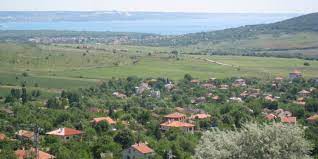The area of Kaleto Osenovo
Overview
In the area where Osenovo is located, there was another, older settlement. Remains of it have been found in the Kaleto area, located in the high part of the village. The fortress was a fortress of the Roman Empire. Copper coins from the time of the Byzantine Emperor Constantine the Great - IV century were found in the land near the "Fortress". The Archaeological Museum in Varna preserves ritual burial objects and valuables from Osenovo, including preserved breastplates and Thracian burials. Remains of a basilica from the end of the 4th century with decorative reliefs have been found in the ancient fortress, one of which (a man holding a large Latin cross in his left hand) is built into the modern church of the village. To the north of the church was discovered an early Christian tomb with frescoes, well studied and described by Al. Minchev and P. Georgiev in 1981 In its present form, the settlement was established in the 19th century after the Crimean War between Russia and Turkey. The old name of the village is Dishbudak ("Ash") and until 1877 it was inhabited by Circassians who left it after the Liberation. It was renamed Osenovo with MH 2820 (promulgated on August 14, 1934). Muhluza is a very large area, with more than 10-15 local names for small areas. It is located north of Aksakovo. The word "mold" is Arabic and means "pure, sincere, faithful." The name is clarified by tracing the phonetic changes that took place with the Bulgarian name of the fortress and the village below it in its adaptation to Turkish phonetics: Maglish / Maklis / Myhlyuz. The center of the area is a hill on which the medieval Bulgarian fortress Maglish landed. It was named Michluz Kale or just Kaleto. The commission proposed the name Fortress. To the west of Kaleto descends a steep valley with rocky shores, on which the eagles built nests - Kartal Dere. The commission proposed the name Orlov Dol, but no one called the area that. Below the Fortress is the Shepherd's Fountain. It was once a favorite place of shepherds. From the fountain descends a deep valley - Choban Dere. They were called Ovcharska Cheshma and Ovcharski Dol, respectively, names that began to be used on an equal footing with others. The stone yamachi (Kayrak bair) - the name bears the peculiarities of the area - a slope dotted with small stones.
Recommended
- Vladislav Varnenchik Museum
- Varna airport
- Varna necropolis
- Grand Mall Varna
- Equestrian base Kalimantsi
- Museum of Health
- Varna Cathedral (Assumption)


 Bulgarian
Bulgarian Romanian
Romanian
